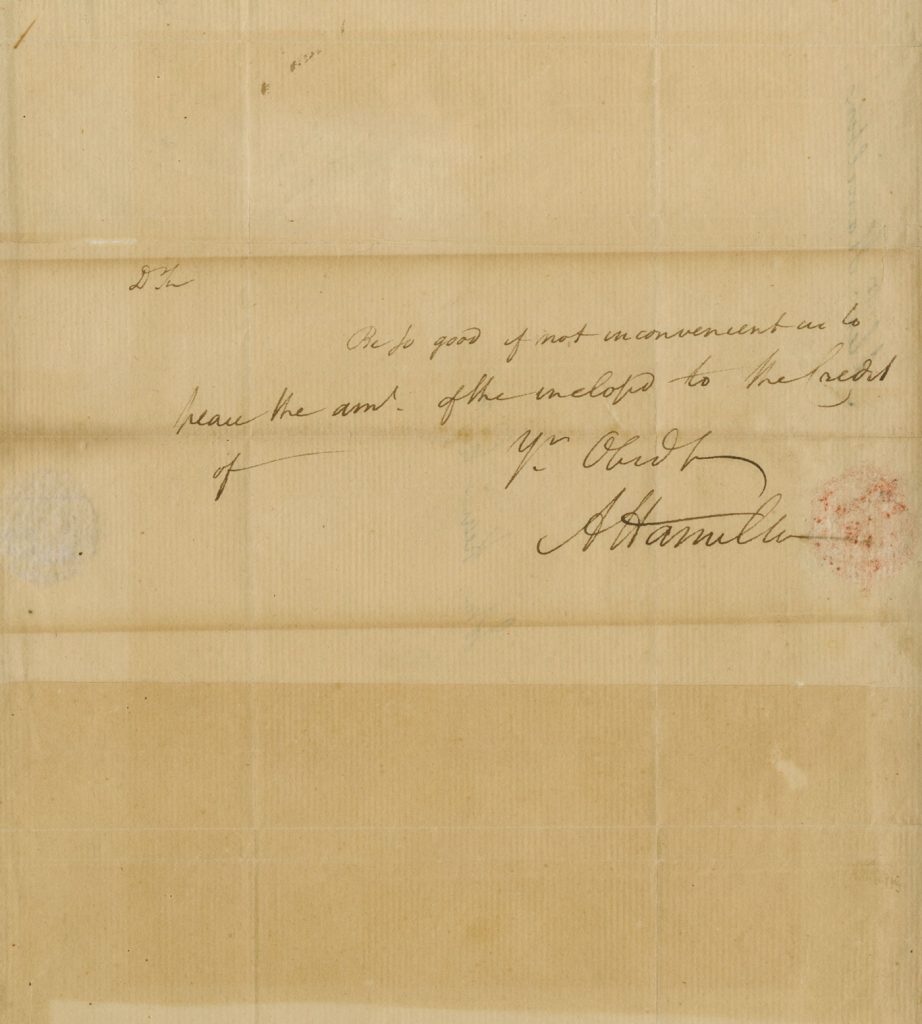Treasury Secretary Alexander Hamilton Deposits His Personal Funds in the Bank of the United States, Which Was Established As Part of His Financial Program


He was quite possibly depositing his own salary, earned for creating the nation’s financial system.
The only Hamilton letter we can recall seeing relating to his personal finances
Alexander Hamilton was the founder of the nation's financial system, and the primary author of the economic policies of the Washington administration. As part of his program, he believed a national bank was necessary to stabilize the nation's financial...
The only Hamilton letter we can recall seeing relating to his personal finances
Alexander Hamilton was the founder of the nation's financial system, and the primary author of the economic policies of the Washington administration. As part of his program, he believed a national bank was necessary to stabilize the nation's financial affairs, establish the United States government’s credit, and handle its financial business under the newly enacted Constitution. He fought for the bank in Congress against the influential opposition of Thomas Jefferson and James Madison. Hamilton prevailed, and the Bank of the United States was chartered by Congress for a term of twenty years on February 25, 1791.
On October 21, 1791, a general meeting of the Bank’s stockholders chose directors, and named Thomas Willing as president and John Kean as cashier. The post of cashier in the 18th century was not that of a teller, as today. The cashier was the man who handled all of the money, and Kean was given the princely salary of $2700 per annum. He accepted the position, and his correspondence with President Washington as he undertook his duties is well known. On December 3, 1791, Kean gave notice in the newspapers that the bank would open on December 5, and begin receiving deposits the following Monday, December 12.
Kean held the cashier’s post until 1794, when he resigned due to ill health. He died the following year. Hamilton remained in his office until January 31, 1795, so Kean’s entire time as Cashier coincided with Hamilton’s term as Treasury Secretary.
Of necessity, the Secretary of the Treasury and the Cashier of the nation’s bank were in regular touch with each other about the financial affairs of the country, and record of much of their correspondence may be found in the National Archives and the Papers of Alexander Hamilton. Their contacts were in part necessary because of the coordination required, as while the Cashier of the Bank received the monies due the United States, the funds were credited not to the Treasury Secretary, but to the Treasurer of the United States (that post was filled by the during the entire Washington administration by Samuel Meredith). As Hamilton himself wrote in February 1794, “…Money deposited in Bank passes immediately to the credit of the Treasurer…” Once thus credited, it was in the Treasury which was under Hamilton’s control.
In addition to the accounts of the United States at the Bank, Hamilton himself had a personal account there. This was certainly appropriate, as he essentially got the Bank established and kept track of its operations. As Hamilton wrote to Kean on March 12, 1794, asking for bank statements, he requested “A Statement of my private account with the Bank for the same period.”
Autograph letter signed, Philadelphia, no date but between December 1791 and August 1794, with the address panel on verso reading “John Kean Esq.”, making a deposit in his personal account. “Dear Sir, Be so good if not inconvenient as to place the amount of the enclosed to the credit of Your Obt. St., A. Hamilton.” Hamilton was paid $3500 per year to serve as Treasury Secretary, and thus made regular periodic deposits. It is tempting to conjecture that this deposit may well have been for his salary, which was earned for creating the nation’s financial system.
This is the only Hamilton letter we can recall seeing relating to his personal finances. Kean has docketed it on verso “Alexr. Hamilton.”

Frame, Display, Preserve
Each frame is custom constructed, using only proper museum archival materials. This includes:The finest frames, tailored to match the document you have chosen. These can period style, antiqued, gilded, wood, etc. Fabric mats, including silk and satin, as well as museum mat board with hand painted bevels. Attachment of the document to the matting to ensure its protection. This "hinging" is done according to archival standards. Protective "glass," or Tru Vue Optium Acrylic glazing, which is shatter resistant, 99% UV protective, and anti-reflective. You benefit from our decades of experience in designing and creating beautiful, compelling, and protective framed historical documents.
Learn more about our Framing Services








































































































